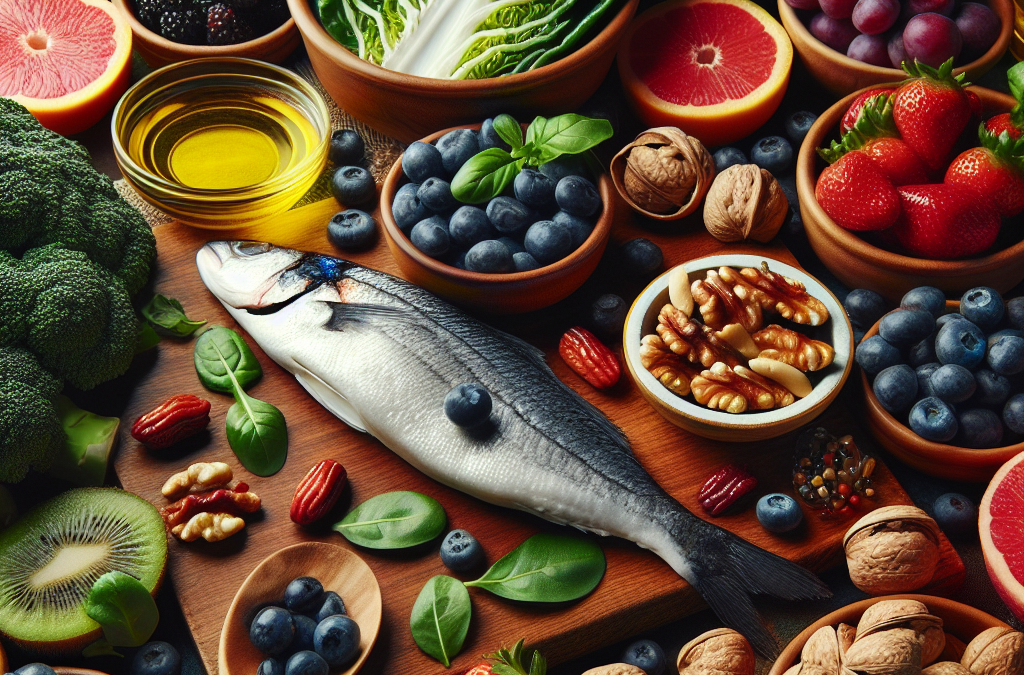When it comes to feeling our best, nutrition plays a huge role. I’ve found that certain whole foods can really help cut down on inflammation and swelling, which is something I’ve dealt with too often. So, let’s dive into my top five picks that have made a difference in my life.
Leafy Greens
Why Leafy Greens are Anti-Inflammatory
Leafy greens like spinach, kale, and swiss chard are packed with vitamins and minerals that our bodies crave. They’re loaded with antioxidants, which are like little defenders against inflammation. I can honestly say that when I incorporate more greens into my meals, I feel more energized and less puffy.
In particular, these greens are rich in vitamin K, which has been shown to play a role in regulating inflammation. It’s pretty wild how adding one ingredient can have such a positive effect on our well-being!
Not to mention, they’re incredibly versatile. Throw them into smoothies, salads, or even stir-fries for a nutrient boost that doesn’t break the bank.
How to Incorporate Leafy Greens into Your Diet
For me, the simplest way to work in leafy greens is by starting the day with a smoothie. Just toss in a handful of spinach or kale, and you won’t even taste it! I often add fruits like bananas or berries to sweeten the deal.
When I make salads, I like to mix darker greens with some lighter ones for texture. Add some nuts or seeds for crunch, and you have a meal that’s not just good for you, but tasty too.
And don’t shy away from using them in cooked dishes. Whether it’s a hearty soup or a quick sauté, greens can elevate your meals and fight inflammation at the same time!
Choosing Fresh vs. Frozen Greens
A common question I get is whether to go for fresh or frozen. Honestly, both have their perks! Fresh greens are fantastic when you can get them, as they maintain crispness and flavor. However, I totally stock up on frozen greens, especially for those busy weeks when I need a quick veggie fix.
Frozen greens are usually flash-frozen right after they’re harvested, locking in nutrients. So if you can’t make it to the store for fresh ones, don’t feel guilty about reaching for the frozen options!
At the end of the day, the best greens are the ones you’ll actually eat, whether they’re fresh from the farmer’s market or picked from your freezer.
Fatty Fish
The Power of Omega-3 Fatty Acids
Let’s talk about fatty fish like salmon, mackerel, and sardines. These guys are treasure troves of omega-3 fatty acids, which are superstars in the fight against inflammation. When I started including more of these into my diet, I noticed a huge difference in my overall joint health.
Omega-3s focus on reducing inflammatory markers in the body, and that’s music to my ears! Research even suggests that these fatty acids can help with mood and even skin health. Definitely a win-win situation!
The flavor of fatty fish is fantastic too. Grill it, bake it, or toss it in a salad—this protein source is not only good for you but also ridiculously tasty.
How Often Should You Eat Fatty Fish?
For my fellow foodies wondering how often to savor these delights, I recommend aiming for at least two servings a week. It doesn’t have to be a chore—I often swap out meat for fish a few times a week to mix things up a bit.
And if you’re not into fish, consider fish oil supplements as an alternative. Keep in mind though, whole food sources are ideal when possible!
It’s all about balance and finding what works for your palate, so test out various recipes and cooking styles until you find your favorites.
Cooking Tips for Fatty Fish
When it comes to cooking fatty fish, I love keeping it simple. A sprinkle of lemon juice, some herbs, and a quick grill can take a plain piece of fish to a whole new level. Plus, it cooks so quickly—perfect for those busy weeknights!
If you’re looking for a heartier dish, try baking it in the oven with some veggies. Just throw it all on a sheet pan, season generously, and it’s a one-stop meal.
Experimenting with marinades is also a fun way to introduce new flavors. My go-to is a soy sauce and honey blend that is easy to whip up and adds an incredible taste!
Nuts and Seeds
The Healthy Fats in Nuts and Seeds
Nuts like walnuts, almonds, and seeds such as chia or flaxseeds are incredible for inflammation. They are not only loaded with healthy fats but also fiber and antioxidants that help fight inflammation in our bodies.
Whenever I have a handful of mixed nuts as a snack, I feel good knowing I’m fueling my body with anti-inflammatory properties. Plus, they’re super easy to pack for on-the-go munching!
Including a variety of nuts and seeds in your diet also helps keep things interesting. With so many options, you can find something to satisfy every craving.
How to Snack Smart with Nuts and Seeds
For me, snacking can be a challenge, but having nuts and seeds on hand has made it way easier. I like to use small portion containers to keep my servings in check while still indulging in that crunchy goodness throughout the day.
Mixing nuts into salads or yogurt can create a delightful contrast in textures, which is this snacking game-changer. Seriously, it takes your average meal to the next level!
And if you’re feeling fancy, try making homemade nut butter. It’s way easier than it sounds, and trust me, once you taste it, you won’t go back to store-bought!
Choosing the Right Nuts and Seeds
When selecting nuts and seeds, I usually go for raw or dry-roasted options since they’re often healthier than their salted or flavored counterparts. You don’t want excess oils and sugars throwing off your health goals!
Get an Amazing Discount on the Best Certified Organic Whole Food Supplement!
And don’t forget about reading labels. Some brands add hidden ingredients that may conflict with your anti-inflammatory goals. Stick to the plain stuff for peaking high nutrient content.
Ultimately, play around with different types to find what you love most. Almonds, hazelnuts, pumpkin seeds—variety is key!
Berries
The Power-Packed Antioxidants in Berries
Let’s be real: berries are pretty much nature’s candy. They are exceptionally high in antioxidants, especially anthocyanins, which have been found to reduce inflammation. When I have a bowl of mixed berries, I feel like I’m indulging while still being healthy!
Research supports that berries, such as blueberries, strawberries, and raspberries, can lower markers of inflammation while also boosting the immune system. I like blending them into smoothies or tossing them on top of oatmeal for an added antioxidant punch.
What’s even cooler is that they’re low in calories and full of fiber, so not only can they help with inflammation, but they can also aid digestive health. Call that a double-dip on benefits!
Creative Ways to Eat More Berries
If you struggle with how to add more berries to your meals, I’ve got you covered. Adding them to breakfast is a no-brainer. Toss them in your yogurt, pancakes, or cereal for a delicious start to your day.
I also love making berry-infused water. Just toss a handful of berries into a pitcher of water; it makes hydration a little more fun!
Do not sleep on desserts, either. Berries can be used in a myriad of recipes; think berry compote over low-fat ice cream or berry parfaits. Trust me; you’ll impress your friends with these easy treats!
Choosing Fresh vs. Frozen Berries
Fresh berries are obviously fantastic when they’re in season, but I regularly stock frozen berries for smoothies and baking. They’re just as nutritious and usually more affordable, especially when fresh berries are out of season.
When I grab frozen berries, I don’t stress about them going bad, which is a huge perk. I’m all about convenience, and frozen fruits make it easy to whip up a health snack in seconds!
So whether fresh or frozen, aim to include berries regularly for those inflammation-fighting benefits.
Turmeric
The Golden Spice with Anti-Inflammatory Properties
How can I talk about inflammation-fighting foods without mentioning turmeric? This golden spice is my go-to when it comes to flavoring up meals while keeping my inflammatory markers at bay. Curcumin is the active compound in turmeric known for its anti-inflammatory effects.
I’ve started adding turmeric into soups, curries, and even my morning smoothies. It’s amazing how a little sprinkle can completely transform a dish.
The science backs me up too, with studies showing that turmeric can help alleviate symptoms of arthritis and other inflammatory conditions. It’s a small spice that packs a big punch!
Tips for Cooking with Turmeric
When using turmeric in cooking, the key is to pair it with black pepper. This combo helps your body absorb the curcumin better! I always make sure to add plenty of black pepper when I’m cooking with it.
And don’t shy away from experimenting with turmeric tea! Mixing turmeric with hot water, honey, and a little pepper makes a delicious and soothing drink. I often drink it before bed to wind down.
It’s also fun to add turmeric to roasted veggies and rice—you’ll be amazed at how much flavor it brings to the table while helping fight inflammation!
Potential Side Effects and Considerations
While turmeric is generally safe for most people, I suggest keeping an eye on how your body reacts. Some folks may experience digestive issues if consumed in large amounts. It’s all about finding that sweet spot.
Also, if you’re on medication, especially blood thinners, check with your healthcare provider before going nuts with turmeric, just to be safe.
But for me and many others, turmeric has been a game-changer—just be cautious and listen to your body!
Frequently Asked Questions
1. Can whole foods really help reduce inflammation?
Absolutely! Whole foods like leafy greens, berries, and fatty fish are packed with nutrients that support the body in reducing inflammation and promoting overall health.
2. How often should I consume these foods for the best results?
For optimal benefits, try to incorporate these foods into your daily meals. Aim for a variety throughout the week to ensure you’re getting a broad spectrum of nutrients.
3. Are there any foods I should avoid to help with inflammation?
Yes, it’s wise to limit processed foods, sugary snacks, and excessive saturated fats, as these can trigger inflammation in your body.
4. Is it better to buy fresh or frozen produce?
Both have their benefits! Fresh produce is fantastic when in season, while frozen options retain nutrients and are convenient. Go with what’s available and fits your budget!
5. Can I use herbs and spices for reducing inflammation too?
Definitely! Spices like turmeric, ginger, and garlic are great anti-inflammatory options to incorporate into your cooking.




